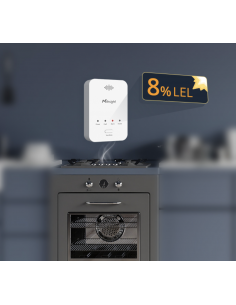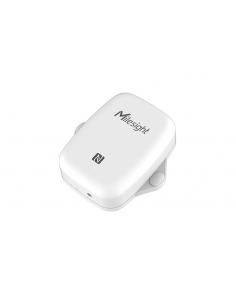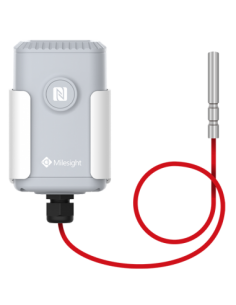Environment Monitoring
LoRaWan® Sensors for Environment Monitoring is one of the most popular IoT devices. The LoRaWAN sensor is a low-power wide-area network (LPWAN) device that uses sub- sensors and are very easy to install and can be used for a variety of purposes such as monitoring the temperature, humidity, wind speed, and rainfall.
Milesight EM500-SWL-868M-L005 LoRaWAN Submersible Water Level Sensor
Milesight EM500-PT100-868M-T800 LoRaWAN® Industrial Temperature Sensor
Milesight EM300-TH-868M LoRaWAN Temperature & Humidity Sensor
Milesight EM500-SWL-868M-L003 LoRaWAN Submersible Water Level Sensor
Milesight EM500-PT100-868M-T500 LoRaWAN® Industrial Temperature Sensor
Milesight EM500-CO2-868M LoRaWAN CO2 & Air Quality Sensor
Milesight EM500-PT100-868M-T200 LoRaWAN® Industrial Temperature Sensor
Milesight EM500-SMTC-868M LoRaWAN® Soil Moisture, Temperature and Electrical...
Milesight EM500-PT100-868M-T050 LoRaWAN® Industrial Temperature Sensor
Buying environmental monitoring sensors
Monitoring sensors are devices that are capable of collecting important environmental data. These might help to understand how a factor is having impact within a certain area and, whether you should take measures to deal with an immediate or future problem.
In AIthings.store you can buy outdoor monitoring sensors provided with highly sensitive technology and specialized in collecting diverse parameters.
What parameters can you measure outdoor?
Outdoor environment can be affected by several factors, such as temperature or air quality. These are measured by a variety of parameters, including particulate matter (PM), ozone (O3), nitrogen dioxide (NO2), and sulfur dioxide (SO2). Our sensors are capable of collecting important environmental data that will certainly help to undertake appropriate actions.
Monitoring ozone levels
One parameter that is often monitored outdoors is ozone (O3). Ozone is a gas that can be harmful to breathe, and levels of it can vary depending on the time of day, season, and weather conditions.
To measure ozone levels, special sensors are used that take samples of the air and then analyze them for O3 content. These sensors are usually located at official monitoring sites that have been designated by government agencies.
Measuring particulate matter (PM)
Another common outdoor air quality parameter is particulate matter (PM). PM refers to tiny particles in the air that can be inhaled and cause health problems. Like ozone, levels of PM can vary depending on the time of day, season, and weather conditions. These particles can appear from:
- Dusts from construction sites, unpaved roads, agricultural operations, and other sources that are large enough to see with the naked eye
- Combustion products such as soot from fireplaces, wood stoves, diesel engines, etc. These are too small to see individually, but can be detected using a light microscope.
- Sea salt spray and dusts from windblown soil.
Monitoring nitrogen dioxide
Nitrogen dioxide (NO2) is a gas that is emitted from burning fossil fuels, such as natural gas, oil, and coal. It is also produced by motor vehicles and other combustion sources.
Exposure to NO2 can cause a variety of health effects, including:
- Irritation of the lungs
- Shortness of breath
- Chest pain
- Increased risk of respiratory infections
NO2 levels are typically higher in urban areas than rural areas. This is because there are more sources of NO2 emissions in urban areas, such as motor vehicles and power plants.
Monitoring carbon dioxide
Carbon dioxide (CO2) is a colorless, odorless gas that is emitted from burning fossil fuels, such as natural gas, oil, and coal. It is also produced by motor vehicles and other combustion sources.
Exposure to CO2 can cause a variety of health effects, including:
- Shortness of breath
- Headache
- Nausea
- Dizziness
Like NO2 levels, CO2 levels are typically higher in urban areas than rural areas due to the presence of more emissions sources.
Monitoring water level
Water level is an important environmental parameter to monitor, as it can indicate the presence of flooding. Flooding can cause a variety of problems, including:
- Disruption of transportation
- Contamination of drinking water
- Infiltration of toxic chemicals into the ground
- Spread of disease
Water level can be monitored using a variety of methods, including our specialized outdoor monitoring sensors.
Monitoring outdoor temperature
Outdoor temperature is another important environmental parameter to monitor, as it can indicate the presence of extreme heat or cold. Extreme weather can cause a variety of problems, including:
- Disruption of transportation
- Power outages
- Agricultural damage
- Increased risk of injuries and fatalities
Outdoor temperature can be monitored using a variety of methods, such as our outdoor monitoring sensors
Monitoring Electrical conductivity
Electrical conductivity is an important environmental parameter to monitor, as it can indicate the presence of pollution. Pollution can cause a variety of problems, including:
- Disruption of transportation
- Contamination of drinking water
- Infiltration of toxic chemicals into the ground
- Spread of disease
Some of our outdoor monitoring sensors can collect electrical conductivity data.
Monitoring soil moisture
Soil moisture is another important environmental parameter to monitor, as it can indicate the presence of drought conditions. Drought can cause a variety of problems, including:
- Crop damage
- Livestock death
- Wildfires
- Increased risk of dust storms
Soil moisture can be monitored using a variety of methods, including weather stations, satellites, and soil moisture sensors.
Benefits of buying monitoring devices
There are many benefits of buying monitoring devices, including:
- Increased safety
- Early warning of environmental problems
- Increased efficiency in resource use
- Better management of natural resources
Buying monitoring devices can help you protect your city, business, or farm from a variety of environmental problems.















